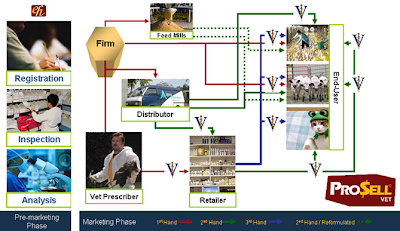Customer Prospecting for Animal Health Business
N.B. Synopsis of ProSell© Vet- Animal Health focused selling skills program- Copyrights Eyad Harfoush- 2006 
Who is a  Prospect
Prospect
The prospect is any individual or organization who has a potential positive effect on our products’ sales, image, perception or regulatory fulfillment. This positive effect may be through direct consumption, reference role, recommendation, prescription or registration. The following chart shows customer groups and relative dynamics in animal health industry.
Click to enlarge

- Referral Among Customer Groups: e.g. Feed-mills à ask for all related farms data, breeders farm à ask for broiler & layers farms data, hatchery à ask for broilers & layers farms data, broilers’ farm à ask for breeders farm data, feed-mills data and slaughterhouses data, slaughterhouse à ask for broilers’ farms. Questions to ask: e.g.
1.From where you buy your ……. (Chicks / feed)
2.To whom usually you sell your ….. (Chicks / feed / broilers / hatching eggs) - Former Colleagues’ Lists: You can always consider the customer list of your former colleague as a nucleolus for your own. Start with refining and updating the list, then start adding to it.
- Secondary Database: includes veterinary services guides and websites of large integrators. The name of the game here is to try thinking who might have needed and collected these data before. Lists of other companies can be helpful if you can access it voluntarily from a colleague in a legally sound way.
- Syndicates’ Directories & Industry Associations : Veterinary syndicate directory which is available on both hard copy and soft copy forms. In addition to associations like Egyptian poultry association, Egyptian Livestock Producers Association … etc.
- Peripheral Vet Authorities: Where you can have access to field practitioners of the region and their data, as well as data about end-users and their capacity. For example, in Egypt the peripheral vet authorities has considerably good database as it distributes FMD vaccines to end-users based on the no. of animals in each.
Prospect Segmentation
Every customer should be treated with absolute respect and care. However, in terms of service and benefits customers essentially gets different treatment according to their ability and potential to satisfy company objectives. Hereunder, we will elaborate about the factors influencing each customer group classifications.
- Annual Farm Capacity: No of birds per cycle X no. of cycles per year
- Scientific Orientation: Degree of scientific / quality orientation versus cost orientation. Usually cost oriented customers are not the best to have.
- Reference Role: The role of the customer in his category e.g. large integrator, leading breeders farm, famous feed factory, premium dairy farm …etc. as this type of customer has a spill-over effect on others who follow his standards.
- Organization indicators: such as headcounts, diversification, financial indicators, investment size… etc. as it indicates a stable customer and possibility to build a long-term business relationship.
- Purchase decision: who has the last word in buying decisions? Who has a consultative role? Who negotiates prices? These questions are important as organizations with centralized purchase decision has a good aspect as it needs less time and resources to create sales. However, it is more risky as the preference here can get easily shifted.
Prospect Segmentation-  Prescribers
Prescribers
- Capacity & no of related farms: The aim here is to calculate the total population following the prescriber’s authority. If there is a shared supervision between more than one vet, consider multiplying by a sharing factor.
example:
If the farms following Dr. John’s authority are A (50,000 birds) , B (120,000 birds) and he has a shared supervision with Dr. Maher on farm C (400,000 birds) with equal power for both. Then the power formula of Dr. John will be:
50,000+120,000+(400,000 * 50%) = 370,000 birds
- Rate of walk-in customers: specially in pet’s specialty, the no. of walk-in customers in the vet. office reflects the role and status of the prescriber more than any other factor. It equals the farm indicator in production animals.
- Quality/ price orientation: in all specialties, you will find quality oriented professionals and cost averse ones. Quality oriented are usually in a higher rank than others except if we promote a price option product.
- Scientific orientation / service orientation: Scientific oriented
 customers are ranked higher than service oriented. As they are less costly and more stable customers. You only need to convince them with the value of your product, they will use it and service will not be a cornerstone in the relation.
customers are ranked higher than service oriented. As they are less costly and more stable customers. You only need to convince them with the value of your product, they will use it and service will not be a cornerstone in the relation. - Reference role: Key Opinion Leaders who have influence on other vets prescriptions are usually granted very high positions apart from their own prescription power. As investing time and resources with them will essentially pay-back through others.
Prospect Segmentation- Retailers
- Distribution fleet & No of Field-Force: in case of a distributor you care more about his active selling. So you need to test his two arms, right arm being the field-force and left arm which is his distribution fleet. Cold chain compatible warehouse and vans are prerequisite when we talk about vaccines distribution.

- Capacity & no of Related Farms: discussed before
- Market Behavior: including price dumping as the most unfavorable wholesalers act. Some distributors have more tendency to sell easy through dumping and gain less profit. While others prefer to sell slowly but surely and achieve a full margin and of course this category is better on long-term than the first.
- Rate of Walk-in Customers: For retailers and vet. pharmacies its essential to consider the rate of their walk-in customers and density of prescription that is related to nearby prescribers’ offices. Needless to mention this gains a little more importance for pets market.
Classifying Customers
Based on the previous factors, you will start classifying your customer list into classes A,B & C for each customer category. There is no distinctive lines that states who is A and who is C, it is a common sense and a matter of consensus in each company or team. Also this classification is dynamic, a class A customer today might deteriorate tomorrow and vice versa. It worth to say that customer classes should never manifest in your manners treating your customers, all customers are respected at the same level, categories are created to detect frequency of visits and service limits for each customer.




Copyrights© 2006. Eyad Harfoush














No comments:
Post a Comment